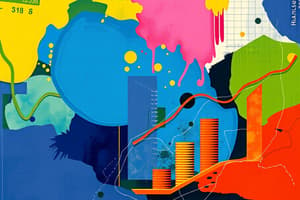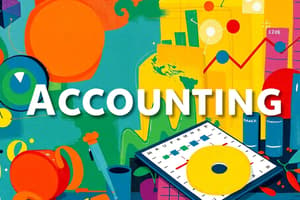Podcast
Questions and Answers
What is the term for costs that can be conveniently traced to a specific cost object?
What is the term for costs that can be conveniently traced to a specific cost object?
- Fixed Costs
- Variable Costs
- Direct Costs (correct)
- Indirect Costs
Which type of cost changes inversely with the level of production?
Which type of cost changes inversely with the level of production?
- Fixed Cost Per Unit (correct)
- Direct Costs
- Indirect Costs
- Variable Cost Per Unit
What is the key distinction between normal costing and actual costing?
What is the key distinction between normal costing and actual costing?
- Actual costing focuses only on direct costs.
- Actual costing relies on budgeted indirect costs.
- Normal costing uses budgeted indirect cost rates. (correct)
- Normal costing uses actual indirect cost rates.
Which of the following expenses is classified as a period cost?
Which of the following expenses is classified as a period cost?
What does 'relevant range' refer to in cost accounting?
What does 'relevant range' refer to in cost accounting?
What are conversion costs primarily associated with?
What are conversion costs primarily associated with?
Which term is used to express partially complete units in terms of complete units?
Which term is used to express partially complete units in terms of complete units?
In process costing, which of the following is true?
In process costing, which of the following is true?
What does a cost driver affect in cost accounting?
What does a cost driver affect in cost accounting?
What are inventoriable costs primarily classified as?
What are inventoriable costs primarily classified as?
What is the formula for calculating the Margin of Safety in revenue?
What is the formula for calculating the Margin of Safety in revenue?
Which of the following best defines the contribution margin ratio?
Which of the following best defines the contribution margin ratio?
What does operating leverage indicate regarding sales volume and profit?
What does operating leverage indicate regarding sales volume and profit?
Which characteristic does not define relevant information?
Which characteristic does not define relevant information?
What does the term 'under costing' refer to in cost allocation?
What does the term 'under costing' refer to in cost allocation?
What is the main limitation of activity-based costing (ABC)?
What is the main limitation of activity-based costing (ABC)?
What does a high degree of operating leverage imply about a business's financial risk?
What does a high degree of operating leverage imply about a business's financial risk?
In Simple Costing Systems, overhead costs are typically allocated based on what?
In Simple Costing Systems, overhead costs are typically allocated based on what?
What is the impact of a decrease in sales volume on profit if a business has high fixed costs and low variable costs?
What is the impact of a decrease in sales volume on profit if a business has high fixed costs and low variable costs?
What characteristic differentiates management accounting from financial accounting?
What characteristic differentiates management accounting from financial accounting?
Which type of information is primarily collected in management accounting?
Which type of information is primarily collected in management accounting?
If Coral Health Solutions is utilizing a unique telemedicine facility to enhance services for remote patients, which competitive strategy are they employing?
If Coral Health Solutions is utilizing a unique telemedicine facility to enhance services for remote patients, which competitive strategy are they employing?
In a linear cost function represented as $Y = A + BX$, what does 'A' signify?
In a linear cost function represented as $Y = A + BX$, what does 'A' signify?
Which of the following best describes the timing of management accounting information collection?
Which of the following best describes the timing of management accounting information collection?
What type of information does financial accounting primarily produce?
What type of information does financial accounting primarily produce?
Which of the following represents a scenario of cost leadership?
Which of the following represents a scenario of cost leadership?
What type of cost can be represented as the slope 'B' in the linear cost function $Y = A + BX$?
What type of cost can be represented as the slope 'B' in the linear cost function $Y = A + BX$?
Which external source of information is most likely relevant for management accountants when making decisions?
Which external source of information is most likely relevant for management accountants when making decisions?
What is the primary purpose of management accounting?
What is the primary purpose of management accounting?
Flashcards are hidden until you start studying
Study Notes
Management Accounting
- Focuses on information for internal management, aiding decision-making related to inventory, products, international expansion, and workforce.
- Helps in planning and controlling the business through budgeting and forecasting, incorporating both historical data and forecasts.
- No legal compliance requirements; emphasizes both financial and non-financial information.
- Non-financial information includes inventory levels, production efficiency, employee data, and industry trends.
- Utilizes quantitative metrics (e.g., sick days) and qualitative feedback for comprehensive analysis.
- Engages with external economic sources to inform decision-making and adapts information gathering frequency as needed.
Financial Accounting
- Primarily serves external stakeholders like shareholders, investors, regulators, and banks.
- Focuses on recording historical financial information via financial statements (Balance Sheet, Income Statement, Cash Flows).
- Required to adhere to established accounting standards (e.g., Australian Accounting Standards).
- Typically reports financial performance annually or quarterly.
Strategic Alignment
- Cost leadership involves competing based on low prices, while differentiation focuses on high product quality.
- Examples:
- Stila Cosmetics aims to launch an anti-aging cream (product differentiation).
- Kontron Computers considers advanced microprocessor production (cost leadership).
- Pelican Industries plans to enhance productivity with a biometric system (cost leadership).
- Coral Health Solutions seeks to implement telemedicine for remote patients (product differentiation).
Cost Functions
- A linear cost function expresses total cost in relation to activity level: Y = A + BX (Y = total cost, A = fixed costs, B = variable cost per unit, X = cost driver).
- Cost drivers are variables influencing total costs over time, with examples including the distance driven determining petrol costs.
Cost Assignment Methods
- Cost assignment involves gathering accumulated costs to specific cost objects, using tracing for direct costs and allocation for indirect costs.
- Direct costs, easily traced and identifiable, contrast with indirect costs, which require rational allocation methods.
- Overhead costs include indirect costs not directly tied to production, with variable costs changing proportionally to activity volume, while fixed costs remain stable.
Costing Approaches
- Normal costing uses budgeted rates for indirect costs, while actual costing uses actual rates.
- Relevant range defines the activity levels where specific cost relationships hold true.
- Key costing types include conversion costs, prime costs (combined direct costs), inventoriable costs (capitalized until sold), and period costs (expensed upon incurrence).
Inventory Types
- Manufacturing inventory consists of direct materials in stock.
- Work-in-process represents unfinished products, while finished goods are ready for sale.
- Equivalent units calculations are used for cost allocation in process costing.
Job vs. Process Costing
- Job costing tracks costs for unique projects or products, while process costing applies to mass production of similar items.
CVP Analysis
- Cost-Volume-Profit analysis examines profit changes alongside sales volume variations, evaluating the impact of sales price, variable costs, and fixed costs.
- Margin of safety quantifies the difference between budgeted and breakeven sales, providing better risk assessment.
Sensitivity Analysis & Contribution Margin
- Sensitivity analysis explores “what if” scenarios affecting profitability.
- Contribution margin represents the amount available to cover fixed costs for each unit sold, while the contribution margin ratio indicates the percentage of sales revenue available for this purpose.
Break-Even Analysis
- Break-even point is where total revenues equal total costs, with formulas relating fixed costs to contribution margins.
- The weighted average process-costing method calculates equivalent units for completed and unfinished products based on total costs.
Operating Leverage
- Reflects the relationship between fixed and variable costs, indicating how changes in sales volume affect profits.
- High fixed costs can yield substantial profits during sales upturns but can also lead to significant losses without revenue.
Relevant vs. Irrelevant Information
- Relevant information is future-oriented and varies among alternatives, while irrelevant information includes historical costs that don’t influence decisions.
Incremental Revenue & Costs
- Incremental revenue refers to additional income from specific activities, while incremental costs denote additional expenses incurred.
Activity-Based Costing (ABC)
- ABC attributes costs to products based on their resource consumption, leading to more accurate product costing and better access to relevant costs.
- Limitations of ABC include high development and implementation costs.
Value Chain Components
- Research & Development encompasses product innovation, while Design touches on product delivery and manufacturing processes.
- Production involves direct material and labor input, Marketing engages with consumer preferences, and Distribution addresses delivery costs.
- Customer Service focuses on maintaining relationships post-sale, influencing future purchasing behavior.
Traditional Costing Systems
- Traditional systems typically use a single volume-based cost driver, risking over or under costing due to uniform application across products.
- These systems contrast with Activity-Based Costing (ABC), which uses multiple drivers for a more precise costing model.
Studying That Suits You
Use AI to generate personalized quizzes and flashcards to suit your learning preferences.




